Papers by Marie-laure Bégout
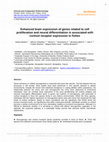
General and Comparative Endocrinology, Oct 1, 2018
Stress enhances or inhibits neurogenesis in mammals and some fish species. The link between the t... more Stress enhances or inhibits neurogenesis in mammals and some fish species. The link between the two processes is still unclear. Most studies have been performed in very specific stressful or altered environments. Despite the known inter-individual divergence in coping abilities within populations, the relationship between the stress axis and neurogenesis has never been addressed in unstressed individuals. Here we correlate brain expression of the pcna (proliferating cell nuclear antigen) and neurod1 (neurogenic differentiation factor 1) genes, two markers of neurogenesis, with transcripts of cortisol receptors in three fish species living in very distinct environments. Within the three species, individuals with the highest expression of neurogenesis genes were also those that expressed the high levels of cortisol receptors. Based on these correlations and the hypothesis that mRNA levels are proxies of protein levels, we hypothesize that within unstressed animals, individuals sensitive to cortisol perceive a similar environment to be more stimulating, leading to increased neurogenesis. Although it is difficult to determine whether it is sensitivity to cortisol that affects neurogenesis capacities or the opposite, the proposed pathway is a potentially fruitful avenue that warrants further mechanistic experiments. Highlights ► Neurogenesis and cortisol receptors genes positively correlate in brain of fishes. ► Three fish species from different environments show similar patterns. ► Unstressed animals were considered. Please note that this is an author-produced PDF of an article accepted for publication following peer review. The definitive publisher-authenticated version is available on the publisher Web site.
HAL (Le Centre pour la Communication Scientifique Directe), Aug 25, 2018
HAL is a multidisciplinary open access archive for the deposit and dissemination of scientific re... more HAL is a multidisciplinary open access archive for the deposit and dissemination of scientific research documents, whether they are published or not. The documents may come from teaching and research institutions in France or abroad, or from public or private research centers. L'archive ouverte pluridisciplinaire HAL, est destinée au dépôt et à la diffusion de documents scientifiques de niveau recherche, publiés ou non, émanant des établissements d'enseignement et de recherche français ou étrangers, des laboratoires publics ou privés.
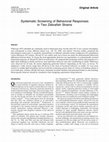
Zebrafish, Sep 1, 2013
Wild-type (WT) zebrafish are commonly used in behavioral tests, but the term WT is not a precise ... more Wild-type (WT) zebrafish are commonly used in behavioral tests, but the term WT is not a precise description, and corresponds to many different strains (e.g., AB, TU, WIK, and others). Previous studies compared the physiological, behavioral, or metabolic characteristics of different zebrafish strains (indigenous WT populations versus laboratory WT strains). AB and TU are widely used, but at least one study has demonstrated behavioral differences between them. To choose the most appropriate strain for our experiments, we systematically screened behavioral responses of AB and TU fish in several assays. We analyzed the locomotion activity and responses to a light/dark challenge in adults and larvae, and exploratory behavior and color conditioning in adults. Differences were observed for all tests, the strains displaying particular behavior depending on the tests. As larvae, TU displayed a wider activity range than AB larvae at the onset of locomotor behavior; as adults, TU were more reactive to sudden light transitions and recovered the swimming activity faster in T-maze or homebase release in novel tank tests, whereas AB fish had more contrasted circadian rhythms and performed better in color learning. Strain-specific behavior should be considered when designing experiments using behavior.
Applied Animal Behaviour Science, May 1, 2020
Abstract In aquaculture, fish are exposed to unavoidable stressors that can be detrimental for th... more Abstract In aquaculture, fish are exposed to unavoidable stressors that can be detrimental for their health and welfare. However, welfare in farmed fish can be difficult to assess, and, so far, no standardized test has been universally accepted as a welfare indicator. This work contributes to the establishment of behavioural welfare indicators in a marine teleost in response to different water quality acute stressors. Groups of ten fish were exposed to high Total Ammonia Nitrogen concentration (High TAN, 18 mg.L-1), Hyperoxia (200 % O2 saturation), Hypoxia (20 % O2 saturation), or control water quality (100% O2 saturation and TAN

HAL (Le Centre pour la Communication Scientifique Directe), May 13, 2018
Awareness of the presence of microplastics, i.e. plastic particles ranging in size from 1 μm to 5... more Awareness of the presence of microplastics, i.e. plastic particles ranging in size from 1 μm to 5 mm, in marine and freshwaters has recently risen but detection and quantification is challenging. Furthermore, whether they pose a risk to aquatic organisms is not yet clear. Fish, for example, have been demonstrated to ingest microplastics particles but the link between quantification of uptake and impact assessment has not yet been made. In this context, we are exploring methods for particles quantification upon feeding juvenile fish with regular food and microplastics and assess whether exposure impacts behavior and growth. For quantification of uptake, we hypothesized that it is possible to analyze the fish tissue by flow cytometry in combination with viSNE, which allows the 2D clustering of particles with different features according to the fluorescence measured. Exposure experiments were carried out for up to three weeks, using different types of microplastic particles and a wide concentration range. In the flow, when particles were mixed with fish tissue, flow cytometry/viSNE was able to differentiate particles natures, numbers and sizes. About 10% of added particles were internalized by the fish from all particles that floated or settled on the bottom. Particles ingestion resulted in a slight impact on behavior. Yet, floating particles were massively incorporated by the fish and significant numbers remained even after 24h of depuration. Based on this, we are currently exploring if continuous feeding with microparticles contaminated food has consequences on juvenile fish growth. Taken together, our study demonstrates the power and limits of flow cytometry/viSNE for microplastics quantification in a complex biological matrix like fish.The setup could be extended to other types and forms of microplastics in different environmental matrices. Moreover, our study sheds light on ecological consequences that microplastics exposure might have on fish.
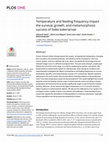
PLOS ONE, Mar 23, 2023
Human-induced climate change impacts the oceans, increasing their temperature, changing their cir... more Human-induced climate change impacts the oceans, increasing their temperature, changing their circulation and chemical properties, and affecting marine ecosystems. Like most marine species, sole has a biphasic life cycle, where one planktonic larval stage and juvenile/adult stages occur in a different ecological niche. The year-class strength, usually quantified by the end of the larvae stage, is crucial for explaining the species' recruitment. We implemented an experimental system for rearing larvae under laboratory conditions and experimentally investigated the effects of temperature and feeding frequencies on survival, development (growth), and metamorphosis success of S. solea larvae. Specific questions addressed in this work include: what are the effects of feeding regimes on larvae development? How does temperature impact larvae development? Our results highlight that survival depends on the first feeding, that the onset of metamorphosis varies according to rearing temperature and that poorly fed larvae take significantly longer to start (if they do) metamorphosing. Moreover, larvae reared at the higher temperature (a +4˚C scenario) showed a higher incidence in metamorphosis defects. We discuss the implications of our results in an ecological context, notably in terms of recruitment and settlement. Understanding the processes that regulate the abundance of wild populations is of primary importance, especially if these populations are living resources exploited by humans.
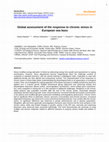
Aquaculture, Nov 1, 2021
Stress modifies energy allocation in fishes by redirecting energy from growth and reproduction to... more Stress modifies energy allocation in fishes by redirecting energy from growth and reproduction to coping mechanisms. However, these adjustments become inappropriate when the challenge consists of sustained or repeated stressors, with the animal entering a maladaptive state. Capacities to cope with additional threats are then altered and compromise survival. The characterization of the responses to chronic stress in fishes helps better understanding the physiological limits in an aquaculture or ecological context. Here, we investigate the coping capacities of European sea bass to multiple and diverse stressors applied over a 3-weeks period. Multiple behavioural (group dispersion and swimming activity) and physiological responses (blood cortisol, osmoregulatory mechanisms, stress-related gene expression, etc.) were evaluated in resting fish or in fish exposed to additional challenges. Resilience to the chronic stress protocol was evaluated 4 months after the end of the chronic stress. Chronically stressed individuals showed reduced growth, lower cortisol response, increased chloride and sodium concentration in the plasma and modified gill gene expression translating osmoregulatory dysfunctions. Chronic stress had no significant effect on plasmatic calcium, lysozyme concentration and osmotic pressure. Increased thigmotaxic behaviour was observed in a new environment behavioural test. Four months after the chronic stress, no significant difference was observed in growth performances and in plasma parameters. Altogether, gills and more generally osmoregulatory functions were found to be the most sensitive to the chronic stress, while only limited changes in growth, activity of the HPI axis, immunity and swimming behaviour were observed when assessed individually. This work demonstrates the necessity of using multiple and diverse endpoints related to different functions to properly assess health and welfare in fishes. Highlights ► Stress load following a chronic stress protocol was assessed in European sea bass ► Our broad approach shows that osmoregulatory functions are the most sensitive ► Measures taken individually can be misleading when evaluating welfare in aquaculture ► Multiple endpoints are needed to properly assess health and welfare in aquaculture
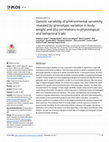
PLOS ONE, Dec 18, 2017
Adaptive phenotypic plasticity is a key component of the ability of organisms to cope with changi... more Adaptive phenotypic plasticity is a key component of the ability of organisms to cope with changing environmental conditions. Fish have been shown to exhibit a substantial level of phenotypic plasticity in response to abiotic and biotic factors. In the present study, we investigate the link between environmental sensitivity assessed globally (revealed by phenotypic variation in body weight) and more targeted physiological and behavioral indicators that are generally used to assess the sensitivity of a fish to environmental stressors. We took advantage of original biological material, the rainbow trout isogenic lines, which allowed the disentangling of the genetic and environmental parts of the phenotypic variance. Ten lines were characterized for the changes of body weight variability (weight measurements taken every month during 18 months), the plasma cortisol response to confinement stress (3 challenges) and a set of selected behavioral indicators. This study unambiguously demonstrated the existence of genetic determinism of environmental sensitivity, with some lines being particularly sensitive to environmental fluctuations and others rather insensitive. Correlations between coefficient of variation (CV) for body weight and behavioral and physiological traits were observed. This confirmed that CV for body weight could be used as an indicator of environmental sensitivity. As the relationship between indicators (CV weight, risk-taking, exploration and cortisol) was shown to be likely depending on the nature and intensity of the stressor, the joint use of several indicators should help to investigate the biological complexity of environmental sensitivity.
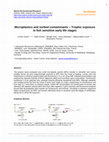
Marine Environmental Research, Oct 1, 2020
The present study evaluated very small microplastic particle (MPs) transfer to zebrafish and mari... more The present study evaluated very small microplastic particle (MPs) transfer to zebrafish and marine medaka larvae via prey experimentally exposed to MPs from the onset of feeding. Larvae were fed Paramecium or Artemia nauplii loaded with fluorescent 1-5 or 10-20 μm MP. Pollutant accumulation was analyzed by optically tracking of benzo [a]pyrene (BaP) and recording cyp1a transcription. Paramecium transferred 1-5 μm particles only, whereas Artemia efficiently transferred both MPs. Although zebrafish and medaka larvae fed from the onset of active food intake (2-3 dph, respectively) on Paramecium and from days 6-7 post-hatch on Artemia nauplii, neither MP accumulation nor translocation to tissues was detected. MP egestion started within few hours after ingestion. Cyp1a induction and fluorescent analyses proved BaP bioavailability after transfer via Paramecium and Artemia. Unicellular or plankton organisms ingest contaminants via MPS and transfer effectively these to sensitive early life-stages of vertebrates, giving rise to whole-life exposure.
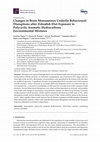
International Journal of Molecular Sciences, Mar 4, 2017
Zebrafish were exposed through diet to two environmentally relevant polycyclic aromatic hydrocarb... more Zebrafish were exposed through diet to two environmentally relevant polycyclic aromatic hydrocarbons (PAHs) mixtures of contrasted compositions, one of pyrolytic (PY) origin and one from light crude oil (LO). Monoamine concentrations were quantified in the brains of the fish after six month of exposure. A significant decrease in noradrenaline (NA) was observed in fish exposed to both mixtures, while a decrease in serotonin (5HT) and dopamine (DA) was observed only in LO-exposed fish. A decrease in metabolites of 5HT and DA was observed in fish exposed to both mixtures. Several behavioural disruptions were observed that depended on mixtures, and parallels were made with changes in monoamine concentrations. Indeed, we observed an increase in anxiety in fish exposed to both mixtures, which could be related to the decrease in 5HT and/or NA, while disruptions of daily activity rhythms were observed in LO fish, which could be related to the decrease in DA. Taken together, these results showed that (i) chronic exposures to PAHs mixtures disrupted brain monoamine contents, which could underlie behavioural disruptions, and that (ii) the biological responses depended on mixture compositions.
Frontiers in Environmental Science, Sep 18, 2019
FIGURE S1 | Larvae standard length (mm) measured at 5 dpf in zebrafish (Danio rerio) exposed to a... more FIGURE S1 | Larvae standard length (mm) measured at 5 dpf in zebrafish (Danio rerio) exposed to a concentration of 10 mg/L of microplastics (MP) and microplastics spiked with oxybenzone (MP + BP3), benzo[a]pyrene (MP + BaP), perfluorooctane sulfonate (MP + PFOS) as well as a mixture of the 3 pollutants (MP + 3POPs) and the control. Data shown as mean ± SD, n=24 per condition. ANOVA F(5, 133)=2.1581, p=0.062.
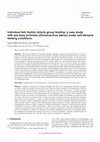
Aquatic Living Resources, Jul 1, 2009
The long term influence of individual biological rhythms on group feed demand behaviour was inves... more The long term influence of individual biological rhythms on group feed demand behaviour was investigated in European sea bass (Dicentrarchus labrax) held under controlled environmental conditions with an on-demand feeding system. The experiment was realized over 219 days with 190 fish distributed on 4 tanks. Sea bass had a mean body mass comprised between 139 g to 183 g. The number of feed demand acts by each individual was calculated daily, and the population could thus be partitioned into three categories (high-, low-and zero-triggering fish). The duration of the period that an individual held high-triggering status could vary, but was 63 ± 16 days on average. The transition period between two highest-triggering fish in one tank was on average 4 ± 4 days. The group feeding rhythm followed the same pattern of feed demand rhythm as the highest-triggering individual fish. When the highest-triggering fish was nocturnal, the totality of feed demand in the group was realized during the night with one peak at 22:00, corresponding to dusk under experimental conditions. When the highest-triggering fish was diurnal, the majority of feed demand in the group was realized during the light period with one peak at 06:00, corresponding to dawn, and/or another at 12:00. This study therefore highlights that sea bass group feeding behaviour is not the sum of individual feed demand behaviours, but is directed by the rhythm and behaviour of a few high-triggering fish. The regular changes of high-triggering fish in the group proved that it was not the identity of these particular fish that was most important for the group, but their role as a feed demand leader.

Journal of Hazardous Materials, Aug 1, 2021
Toxicity of polyethylene (PE) and polyvinyl chloride (PVC) microplastics (MPs), either virgin or ... more Toxicity of polyethylene (PE) and polyvinyl chloride (PVC) microplastics (MPs), either virgin or spiked with chemicals, was evaluated in two short-lived fish using a freshwater species, zebrafish, and a marine species, marine medaka. Exposures were performed through diet using environmentally relevant concentrations of MPs over 4 months. No modification of classical biomarkers, lipid peroxidation, genotoxicity or F0 behaviour was observed. A significant decrease in growth was reported after at least two months of exposure. This decrease was similar between species, independent from the type of MPs polymer and the presence or not of spiked chemicals, but was much stronger in females. The reproduction was evaluated and it revealed a significant decrease in the reproductive output for both species and in far more serious numbers in medaka. PVC appeared more reprotoxic than PE as were MPs spiked with PFOS and benzophenone-3 compared to MPs spiked with benzo[a]pyrene. Further, PVC-benzophenone-3 produced behavioural disruption in offspring larvae. These results obtained with two species representing different aquatic environments suggest that microplastics exert toxic effects, slightly different according to polymers and the presence or not of sorbed chemicals, which may lead in all cases to serious ecological disruptions.
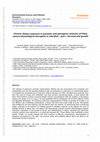
Environmental Science and Pollution Research, Mar 22, 2014
The release of polycyclic aromatic hydrocarbons (PAHs) into the environment has increased very su... more The release of polycyclic aromatic hydrocarbons (PAHs) into the environment has increased very substantially over the last decades leading to high concentrations in sediments of contaminated areas. To evaluate the consequences of long-term chronic exposure to PAHs, zebrafish were exposed, from their first meal at 5 days post fertilisation until they became reproducing adults, to diets spiked with three PAH fractions at three environmentally relevant concentrations with the medium concentration being in the range of 4.6-6.7 μg g −1 for total quantified PAHs including the 16 US-EPA indicator PAHs and alkylated derivatives. The fractions used were representative of PAHs of pyrolytic (PY) origin or of two different oils of differing compositions, a heavy fuel (HO) and a light crude oil (LO). Fish growth was inhibited by all PAH fractions and the effects were sex specific: as determined with 9-month-old adults, exposure to the highest PY inhibited growth of females; exposure to the highest HO and LO inhibited growth of males; also, the highest HO dramatically reduced survival. Morphological analysis indicated a disruption of jaw growth in larvae and malformations in adults. Intestinal and pancreatic enzyme activities were abnormal in 2-month-old exposed fish. These effects may contribute to poor growth. Finally, our results indicate that PAH mixtures of different compositions, representative of situations encountered in the wild, can promote lethal and sublethal effects which are likely to be detrimental for fish recruitment.
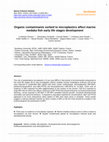
Marine Pollution Bulletin, May 1, 2020
The role of polyethylene microplastics 4-6 μm size (MPs) in the toxicity of environmental compoun... more The role of polyethylene microplastics 4-6 μm size (MPs) in the toxicity of environmental compounds to fish early life stages (ELS) was investigated. Marine medaka Oryzias melastigma embryos and larvae were exposed to suspended MPs spiked with three model contaminants: benzo(a)pyrene (MP-BaP), perfluorooctanesulfonic acid (MP-PFOS) and benzophenone-3 (MP-BP3) for 12 days. There was no evidence of MPs ingestion but MPs agglomerated on the surface of the chorion. Fish ELS exposed to virgin MPs did not show toxic effects. Exposure to MP-PFOS decreased embryonic survival and prevented hatching. Larvae exposed to MP-BaP or MP-BP3 exhibited reduced growth, increased developmental anomalies and abnormal behavior. Compared to equivalent waterborne concentrations, BaP and PFOS appeared to be more embryotoxic when spiked on MPs than when alone in seawater. These results suggest a relevant pollutant transfer by direct contact of MPs to fish ELS that should be included in the ecotoxicological risk assessment of MPs. Highlights ► There was no evidence of microplastic ingestion. ► Marine medaka embryos were in direct contact to microplastics via their chorion. ► Aquatic contaminants spiked on microplastics induced acute and developmental toxicity.
HAL (Le Centre pour la Communication Scientifique Directe), Sep 1, 2012
HAL (Le Centre pour la Communication Scientifique Directe), Apr 22, 2013
National audienc
HAL (Le Centre pour la Communication Scientifique Directe), Oct 3, 2013
HAL (Le Centre pour la Communication Scientifique Directe), Mar 19, 2012

International audienceMicroplastic (MP) occurrence is ubiquitous in fresh and marine waters and s... more International audienceMicroplastic (MP) occurrence is ubiquitous in fresh and marine waters and species living inEstuary are particularly exposed to this kind of pollution. In this context, the Seine River isinteresting for investigating the impacts of MP on fish, because of intense and numerous humanactivities through its watershed. The goal of this study is to evaluate the fate and impact of MPingestion using experimental exposure of the common sole, Solea solea, a representative species ofthe Seine Estuary. Larvae of fish (from 7 days post hatch (dph) to 42 dph) were exposed during 2hours to MP particles before (7 dph), during (21 and 22 dph) and after metamorphosis (41 and 42dph). Three types of industrial MP were chosen with different properties (middle size floating (27-35μg mL-1, DC: 50 ng mL-1). Post-exposurem, d=0.99), middle size sinking (27-32μg mL-1, DC: 50 ng mL-1). Post-exposurem, d=1.20) and large size sinking (63- 75μg mL-1, DC: 50 ng mL-1). Post-exposurem, d=1.20).In addition, at the last stage, fish were also exposed to natural plastic particles collected in the SeineRiver and ground into a fraction with a size less than 100 μg mL-1, DC: 50 ng mL-1). Post-exposurem (PVC, PE, PET, PS and PP testedseparately). After exposure, fish which had ingested MP were counted (Figure 1) and isolated tomonitor egestion. Solea solea ingested all types of plastics in variable (1 to more than 100)quantities and egested them on average less than 24 hours after exposure at all stages. A behaviouralchallenge, was performed on MP contaminated larvae. Behavioral responses of fish did not seem tobe affected by MP exposures before metamorphosis compared to controls but distance moveddecreased during metamorphosis for fish that had ingested MP particles. This could be explained bythe fact that before metamorphosis fish can still use yolk energy reserve and are thus less affected byMP than later on when external feeding becomes mandatory








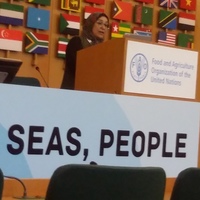


Uploads
Papers by Marie-laure Bégout